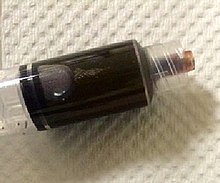
Back ميتهيموغلوبينية الدم Arabic Methemoglobinemija BS Metahemoglobinèmia Catalan Methemoglobinémie Czech Methämoglobinämie German Metahemoglobinemia Spanish Methemoglobineemia Estonian Metahemoglobinemia Basque مثیموگلوبینمی Persian Méthémoglobinémie French
| Methemoglobinemia | |
|---|---|
| Other names | Hemoglobin M disease,[1] |
 | |
| Chocolate-brown blood due to methemoglobinemia | |
| Specialty | Toxicology, haematology |
| Symptoms | Headache, dizziness, shortness of breath, nausea, poor muscle coordination, blue-colored skin[2] |
| Causes | Benzocaine, nitrites, dapsone, genetics[3] |
| Diagnostic method | Blood gas[3] |
| Differential diagnosis | Argyria, sulfhemoglobinemia, heart failure[3] |
| Treatment | Oxygen therapy, methylene blue[3] |
| Prognosis | Generally good with treatment[3] |
| Frequency | Relatively uncommon[3] |
Methemoglobinemia, or methaemoglobinaemia, is a condition of elevated methemoglobin in the blood.[2] Symptoms may include headache, dizziness, shortness of breath, nausea, poor muscle coordination, and blue-colored skin (cyanosis).[2] Complications may include seizures and heart arrhythmias.[3][4]
Methemoglobinemia can be due to certain medications, chemicals, or food or it can be inherited.[2] Substances involved may include benzocaine, nitrites, or dapsone.[3] The underlying mechanism involves some of the iron in hemoglobin being converted from the ferrous [Fe2+] to the ferric [Fe3+] form.[3] The diagnosis is often suspected based on symptoms and a low blood oxygen that does not improve with oxygen therapy.[3] Diagnosis is confirmed by a blood gas.[3]
Treatment is generally with oxygen therapy and methylene blue.[3] Other treatments may include vitamin C, exchange transfusion, and hyperbaric oxygen therapy.[3] Outcomes are generally good with treatment.[3] Methemoglobinemia is relatively uncommon, with most cases being acquired rather than genetic.[3]
- ^ "Methemoglobinemia". MedlinePlus Medical Encyclopedia. U.S. National Library of Medicine. Retrieved 8 June 2019.
- ^ a b c d "NCI Dictionary of Cancer Terms". National Cancer Institute. 2 February 2011. Retrieved 21 December 2019.
- ^ a b c d e f g h i j k l m n o Ludlow JT, Wilkerson RG, Nappe TM (January 2019). "Methemoglobinemia". StatPearls [Internet]. Treasure Island (FL): StatPearls Publishing. PMID 30726002.
- ^ Wettstein ZS, Yarid NA, Shah S (December 2022). "Fatal methaemoglobinemia due to intentional sodium nitrite ingestion". BMJ Case Reports. 15 (12): e252954. doi:10.1136/bcr-2022-252954. PMC 9748921. PMID 36524260.